Aphrodite
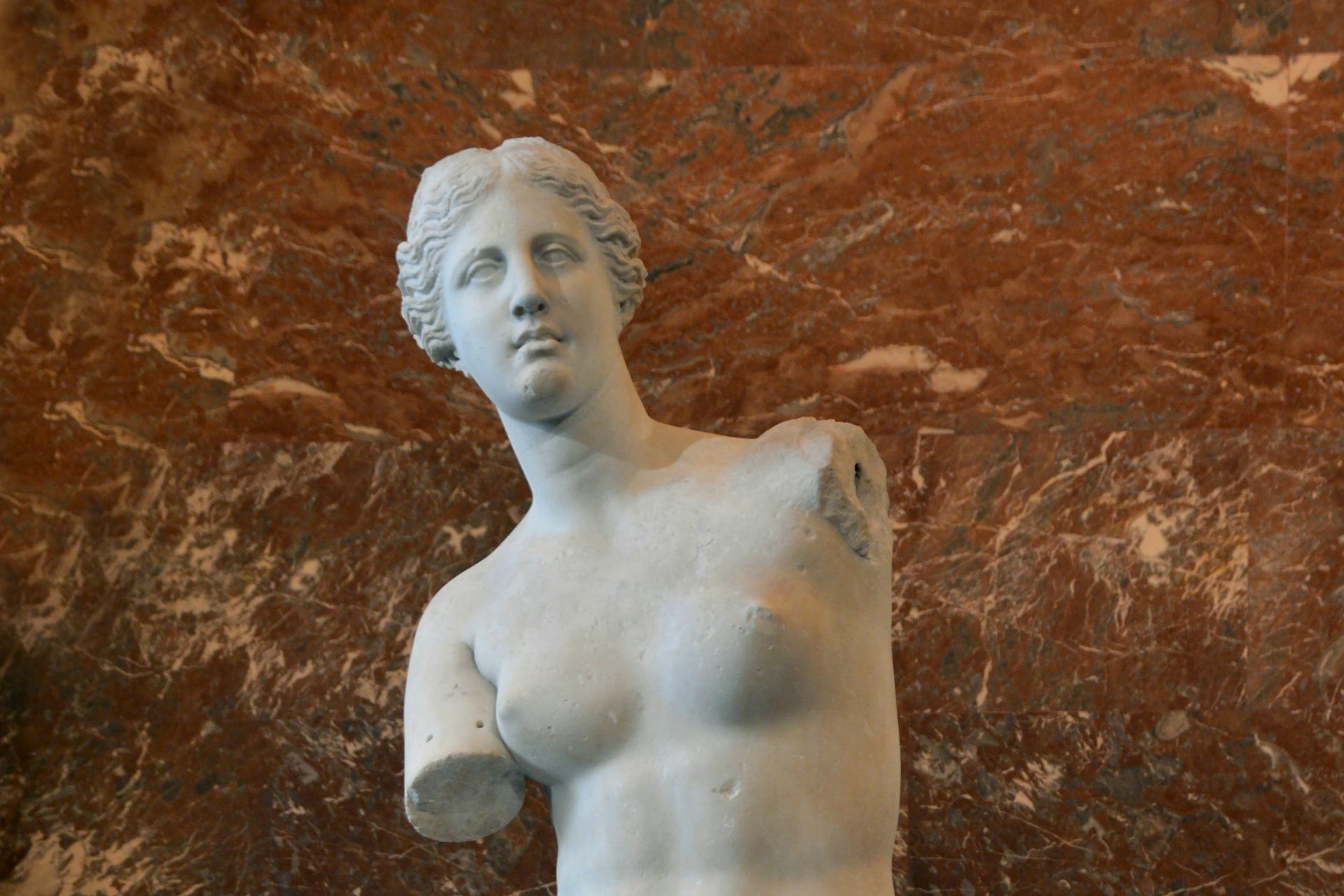
The "Venus de Milo," a marble statue of Aphrodite discovered on the island of Milos, attributed to Alexander of Antioch (between 150 and 125 BCE)
Louvre Museum / Livioandronico2013CC BY-NC-SA 4.0Overview
Aphrodite was one of the Twelve Olympians and the Greek goddess of love, desire, and procreation. Both generously nurturing and passionately destructive, she embodied all the possibilities that love and passion had to offer.
Aphrodite lived together with the other gods on Mount Olympus. She was married to Hephaestus, god of the forge and craftsmanship, though she often took other lovers—including her husband’s more handsome brother Ares, the god of war.
Key Facts
What were Aphrodite’s attributes?
Aphrodite was the goddess of love and beauty; unsurprisingly, then, she was imagined as exceedingly beautiful and youthful herself. She was often represented scantily clad (or even completely nude).
Aphrodite’s attributes included her enchanted girdle and a mirror, while her favorite animals included birds such as the dove or swallow. She was often shown in the company of her son Eros, the personification of love.
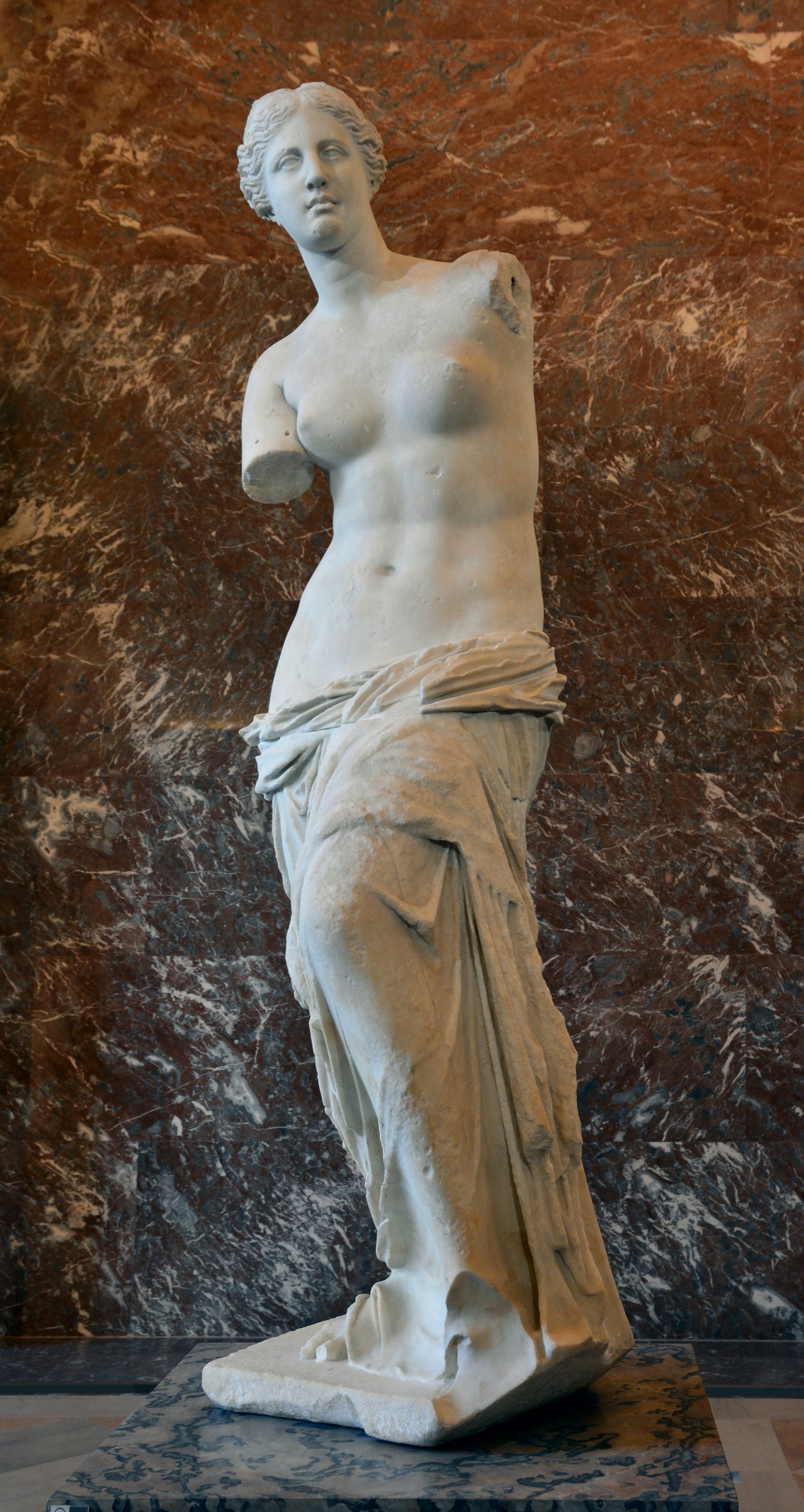
The "Venus de Milo," a marble statue of Aphrodite discovered on the island of Milos, attributed to Alexander of Antioch (between 150 and 125 BCE)
Louvre Museum / Livioandronico2013CC BY-NC-SA 4.0How was Aphrodite born?
There are different versions of Aphrodite’s birth. In one version, known from Homer’s epics, she was the daughter of Zeus, the supreme god of the Greeks, and the goddess Dione.
But the best-known account of Aphrodite’s birth comes from Hesiod’s Theogony. According to this epic poem, Aphrodite emerged from the sea foam that bubbled up after Uranus’ severed genitals were thrown into the sea.
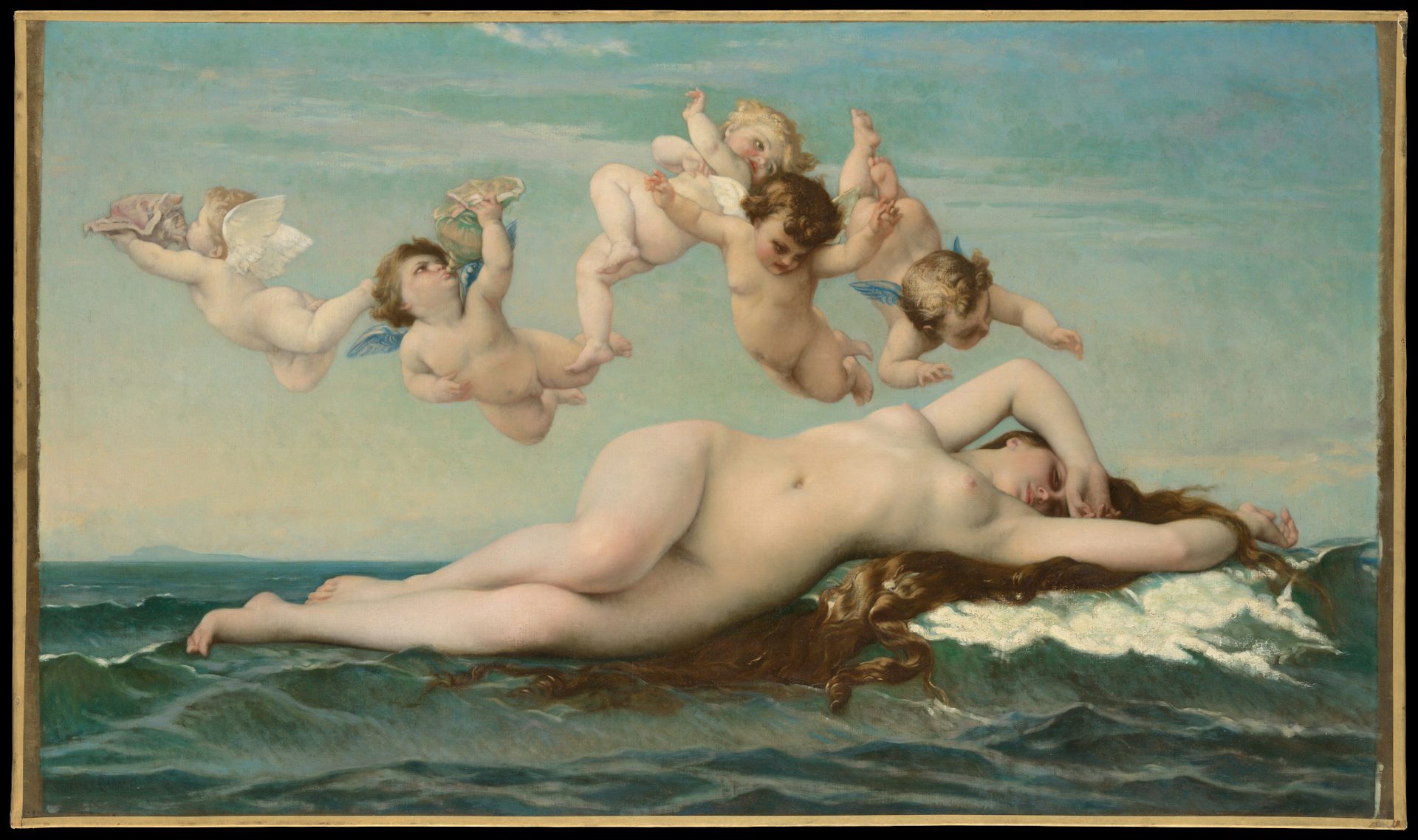
The Birth of Venus by Alexandre Cabanel (1875)
The Metropolitan Museum of ArtPublic DomainWhere was Aphrodite worshipped?
Aphrodite was worshipped throughout the ancient Greek world, but her most important cult centers were on the islands of Cyprus and Cythera. There she was honored with beautiful sanctuaries and temples, as well as festivals called Aphrodisia.

The remains of the sanctuary of Aphrodite at Paphos in Cyprus
rene boulayCC BY-SA 3.0The Judgment of Paris
As the symbol of all desire and longing, Aphrodite exerted an immense influence on mortal affairs. Perhaps most notably, she played a key role in provoking the Trojan War.
According to this myth, Aphrodite became embroiled in a beauty contest with her fellow goddesses Hera and Athena. Each of the three goddesses claimed that she was the most beautiful and therefore deserved to win a golden apple inscribed with the words “to the fairest.”
The gods chose the young Trojan prince Paris to be the judge of this contest. Each of the three goddesses tried to bribe Paris, but in the end it was Aphrodite who won him over by promising him the most beautiful woman in the world as his bride.
After Paris chose in Aphrodite’s favor, she kept her promise and caused Helen of Sparta, the most beautiful woman in the world, to fall in love with Paris. But when the two lovers ran off, Helen’s husband Menelaus raised an army and sailed to Troy to retrieve his wife—thus sparking the Trojan War.
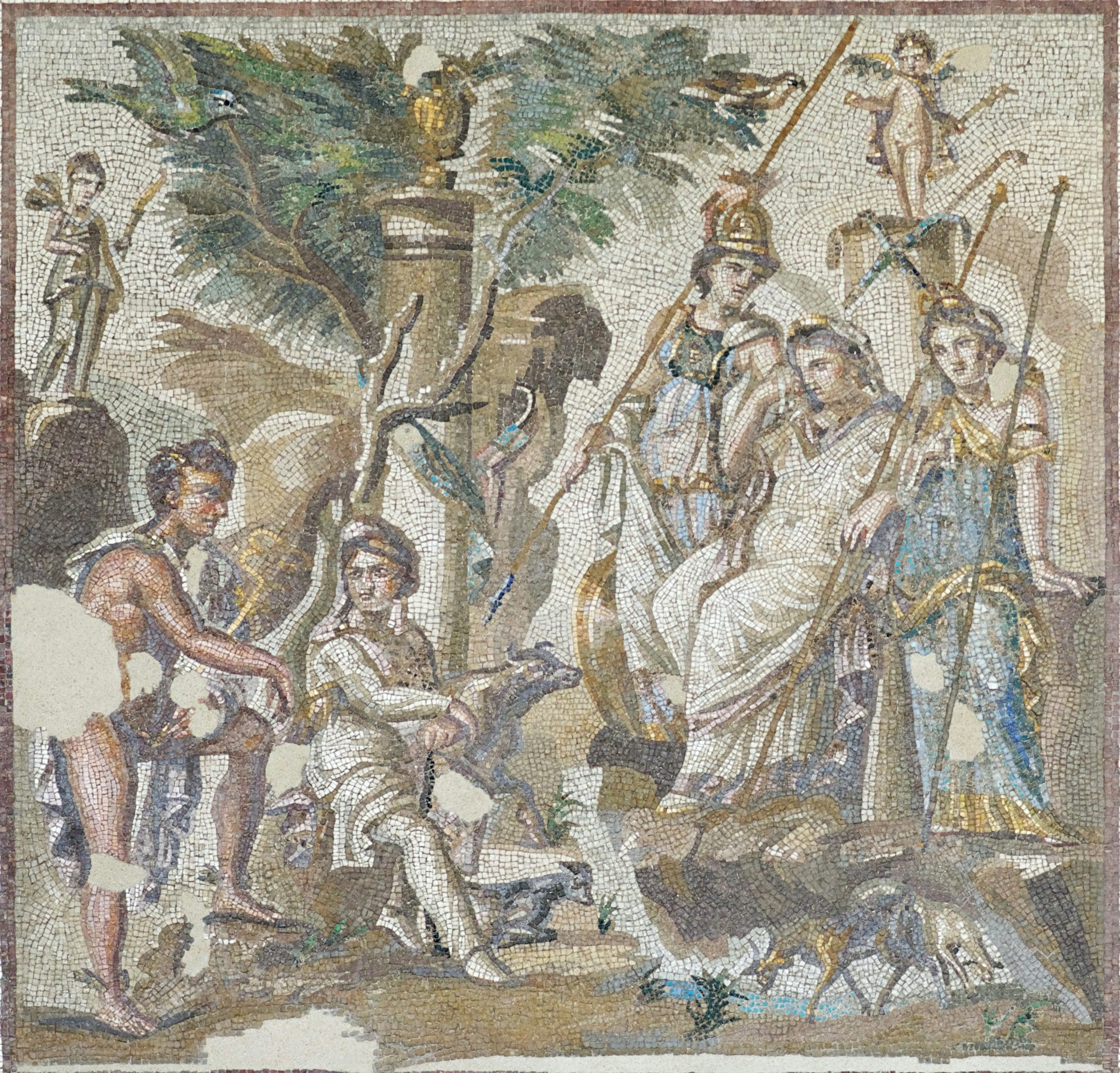
Mosaic showing the Judgment of Paris from the triclinium of the Atrium House in Antioch-on-the-Orontes (ca. 115–150 CE)
Louvre Museum, Paris / Marie-Lan NguyenPublic DomainEtymology
In ancient times, the Greeks believed the name “Aphrodite” derived from the Greek word aphros, meaning “sea foam.” In the Theogony, the poet Hesiod described how Aphrodite was born from the foam that bubbled up after Cronus severed the genitalia of his father Uranus and cast it into the sea. He thus interpreted Aphrodite’s name as meaning “born from sea foam.”[1]
Nowadays, most scholars regard this derivation as a folk etymology. Some have sought various Indo-European origins for the name, tracing it to words such as *abʰor- (“very”), *dʰei- (“to shine”), or *abrhá- (“cloud”).[2] Others, such as Martin West, have searched for a Semitic source.[3] Still others have turned to Etruscan for the name’s origin, comparing it to (e)prϑni, an Etruscan honorific meaning “lord” (in this case, Aphrodite’s name would mean “the lady”).[4]
In short, the etymology of the name “Aphrodite” is highly uncertain and likely originated from a non-Greek language.[5] TheThe Indeed, there is no evidence of the goddess during the earliest periods of Greek history (the Bronze Age or Mycenaean period, ca. 1600–1100 BCE); she may have originally been an Eastern goddess later adopted by the Greeks.[6]
Pronunciation
English
Greek
Aphrodite Ἀφροδίτη Phonetic
IPA
[af-ruh-DAHY-tee] /ˌæf rəˈdaɪ ti/
Other Names
Aphrodite had two common alternative names in ancient literature: Cypris and Cytherea, referring to her close association with the islands of Cyprus and Cythera, respectively.
Epithets
Aphrodite was most commonly described as ourania (“heavenly”) and pandēmos (“of all people”). Many epithets, such as chryseē (“golden”), dia (“brilliant”), or eustephanos (“well-crowned”), related to her attributes or appearance. In other cases, Aphrodite's epithets reflected her duality as a goddess of bliss as well as destruction—she was known as both philommeidēs (“smile-loving”) and skotia (“dark one”).
Attributes
Domains
Aphrodite was worshipped primarily as the goddess of erotic love and women. In these capacities, she was honored in connection with sex, marriage, and childbirth. But her functions also extended into other areas: for example, Aphrodite was a goddess not only of women’s fertility and childbirth, but also of the fertility of the earth—of vegetation and farming. Aphrodite was also seen, naturally enough, as the patron of prostitutes. Perhaps somewhat less naturally, another of her functions was the protection of sailors at sea.
Iconography
In art and literature, Aphrodite’s chief attribute was always her stunning physical beauty. As if this were not enough, she was also said to possess a magical girdle that made the person wearing it irresistible. There is a famous scene in Homer’s Iliad where Hera borrows Aphrodite’s girdle to seduce Zeus.[7]
Unlike the other Greek goddesses, who were usually depicted as modestly clothed, Aphrodite was almost always represented in various stages of undress. This trend began at the end of the fifth century BCE and quickly caught on, epitomized in Praxiteles’ statue Aphrodite of Cnidos (345/340 BCE) and Apelles of Cos’ painting of Aphrodite rising from the sea (Aphrodite Anadyomenē, or the “Aphrodite of Cos”). These works were endlessly copied throughout antiquity.
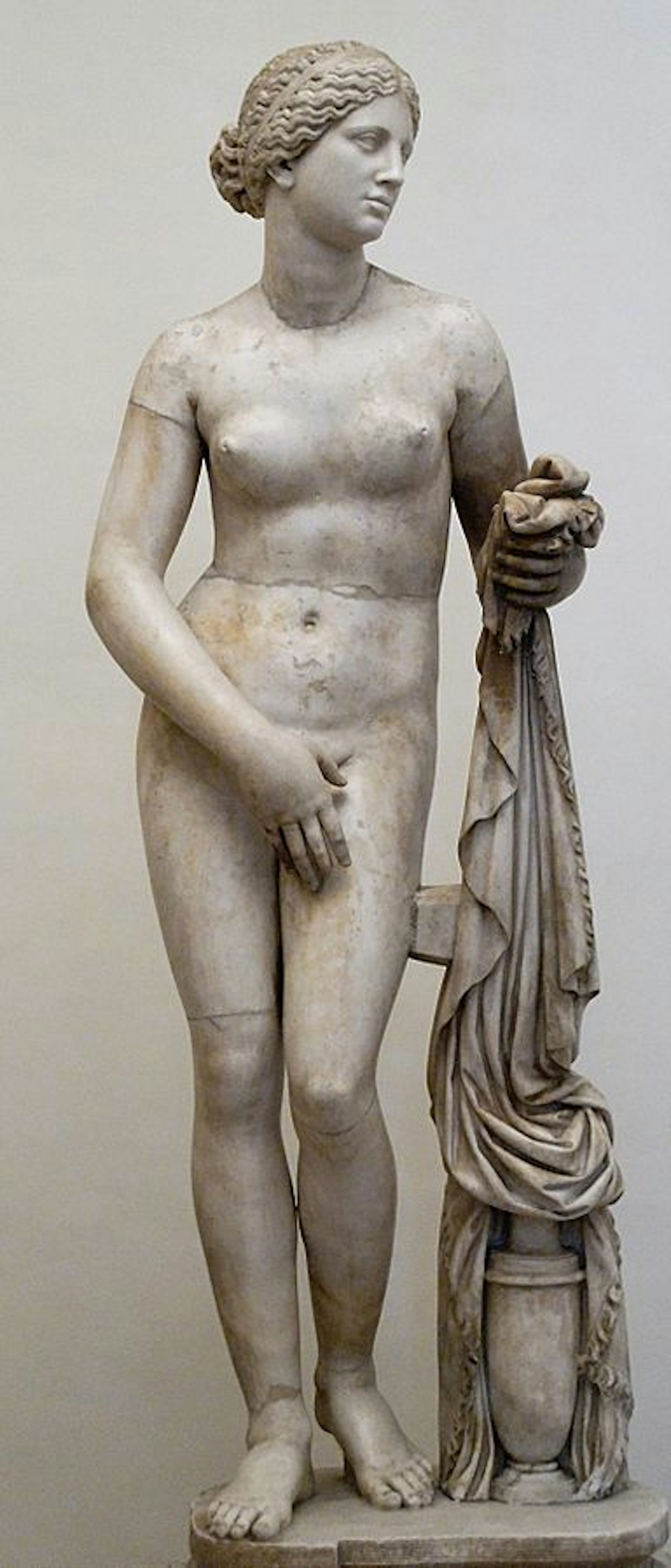
"Cnidian Aphrodite," Roman copy of 4th-century BCE Greek original by Praxiteles.
Wikimedia CommonsPublic Domain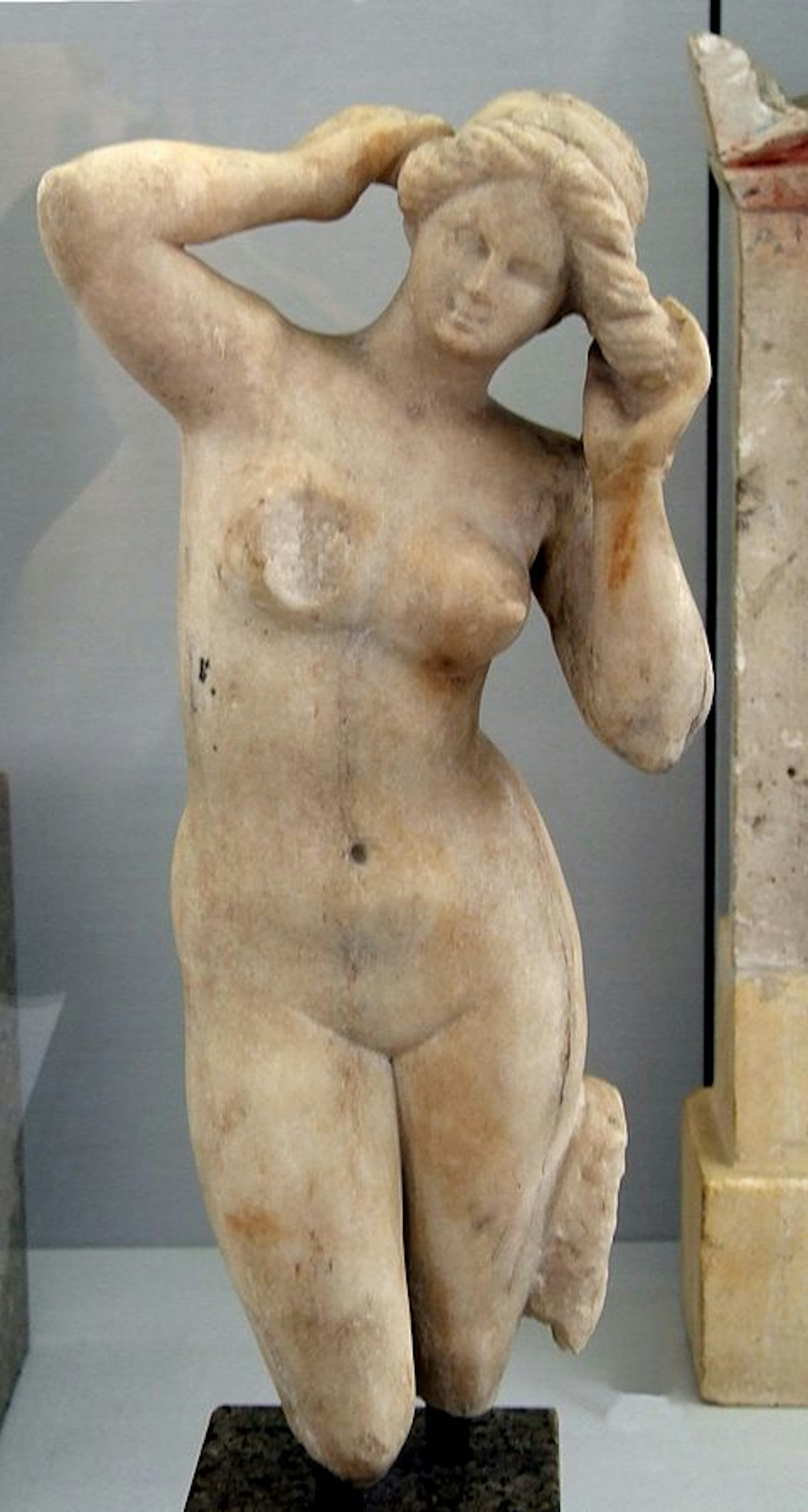
"Aphrodite Anadyomene," 2nd/1st-century BCE statue inspired by 4th-century BCE painting by Apelles of Cos.
shakko / Wikimedia CommonsCC BY-SA 3.0Aphrodite was often depicted in the company of other gods, especially Eros or the other Erotes (gods of love usually said to have been the children of Aphrodite). Other times her entourage included the Graces, the Nereids, or the wild half-goat Pan.
Finally, Aphrodite was sometimes represented as victorious and armed for war, with helmet, shield, and weapons. This was how she was shown, for example, in Corinth, Cythera, and Sparta.[8]
Symbols
Aphrodite had various animal and plant symbols that helped distinguish her in antiquity. She was especially closely associated with male goats, but also with doves, sparrows, swallows, and swans, all of which were often imagined as pulling her chariot or serving as her messengers.[9] Another one of Aphrodite’s sacred animals was the tortoise.[10]
Aphrodite’s sacred plants included the apple, rose, myrtle, and poppy.[11]
Family
Family Tree
Mythology
Origins
There were at least two well-known versions of the birth (or creation) of Aphrodite. The first, told by Hesiod in the Theogony, placed the creation of Aphrodite at the beginning of mythical time, when the Titan Cronus, son of Uranus, rose up against his father.
Uranus was a primordial deity and the ruler of the universe whose union with Gaia, the earth, started all things. According to Hesiod, when Cronus overthrew his father, he cut off Uranus’ genitals and cast them in the sea near the island of Cythera. From Uranus’ blood arose the Erinyes, Giants, and nymphs, and from the foam that swirled around his severed genitals came Aphrodite. Born near Cythera, Aphrodite first came ashore on Cyprus (thus, the story of the goddess’s birth mentions her two most sacred sites).

The Birth of Venus by Sandro Botticelli (1483–1485). Uffizi, Florence, Italy.
Google Arts and CulturePublic DomainHesiod’s poetry brings the savage scene to life:
Then the son from his ambush stretched forth his left hand and in his right took the great long sickle with jagged teeth, and swiftly lopped off his own father's members and cast them away to fall behind him. And not vainly did they fall from his hand; for all the bloody drops that gushed forth Earth received, and as the seasons moved round she bare the strong Erinyes and the great Giants with gleaming armour, holding long spears in their hands and the Nymphs whom they call Meliae all over the boundless earth. And so soon as he had cut off the members with flint and cast them from the land into the surging sea, they were swept away over the main a long time: and a white foam spread around them from the immortal flesh, and in it there grew a maiden. First she drew near holy Cythera, and from there, afterwards, she came to sea-girt Cyprus, and came forth an awful and lovely goddess, and grass grew up about her beneath her shapely feet. Her gods and men call Aphrodite, and the foam-born goddess [Greek: aphrogenea thean] and rich-crowned Cytherea, because she grew amid the foam [Greek: en aphrōi], and Cytherea because she reached Cythera, and Cyprogenes because she was born in billowy Cyprus, and Philommedes because sprang from the members. And with her went Eros, and comely Desire followed her at her birth at the first and as she went into the assembly of the gods. This honour she has from the beginning, and this is the portion allotted to her amongst men and undying gods, -- the whisperings of maidens and smiles and deceits with sweet delight and love and graciousness.[24]
The other version of Aphrodite's origins, told by Homer, presented Aphrodite as the child of Zeus and Dione—a mysterious figure who may have been a Titan or an Oceanid. However, Homer did not narrate her conception or birth; he simply described Aphrodite as the daughter of Dione.[25]
The contrasting stories surrounding Aphrodite's origins created some confusion among the ancient Greeks, a situation that Plato attempted to solve in his dialogue the Symposium. Speaking through the character of Pausanias, Plato suggested that Aphrodite Urania (“heavenly Aphrodite”) and Aphrodite Pandemos (“common Aphrodite,” or “Aphrodite of the people”), the most popular epithets for the goddess, were in fact separate deities merged together in the collective consciousness of the Greeks.
According to Plato, Aphrodite Pandemos stood for the “lower” or “common” sort of sexual love between a male and female. Aphrodite Urania, on the other hand, stood for the “higher,” more rarefied kind of love that could only exist between two males—more specifically, between an erastes, an older, wizened man, and an eromenos, a young man or boy blossoming into adulthood.[26]
Aphrodite the Lover
Many stories of Aphrodite centered on her famous beauty and sexual passions, as well as the passions she inspired in others.
Ares
Aphrodite was married (at least for a time) to Hephaestus, but took little joy in the crippled and gruff god of the forge. In fact, her most enduring love was for Ares, the god of war.
A famous and amusing myth about Aphrodite’s affair with Ares is told in Homer’s Odyssey. Hephaestus, so the story goes, found out that his wife was sleeping with Ares in his own bed and decided to teach the wayward lovers a lesson. He fashioned a net so fine that it was invisible to the naked eye and placed it on the bed. The next time Aphrodite and Ares made love, they became trapped in the adamantine net. Hephaestus then appeared and exposed the couple, in flagrante, to the ridicule of the other gods.[27]
Anchises
In one tale, Aphrodite appeared as a beautiful mortal and seduced Anchises, a lonely shepherd from the foothills of Mount Ida, near the legendary city of Troy. The most detailed account of the myth is found in the fifth Homeric Hymn.
Anchises was led to believe that Aphrodite was a virgin; subsequently, he became overwhelmed with the desire to sleep with her. After the consummation of their union, Aphrodite revealed her true identity and informed Anchises she was pregnant with a demigod named Aeneas who was to become a Trojan hero (later myths presented him as the ancestor of the Romans).
The fifth Homeric Hymn ends with Aphrodite warning Anchises not to reveal their affair to anybody: “And now because of you,” says Aphrodite, “I shall have great shame among the deathless gods henceforth, continually… But if you tell all and foolishly boast that you lay with rich-crowned Aphrodite, Zeus will smite you in his anger with a smoking thunderbolt. Now I have told you all. Take heed: refrain and name me not, but have regard to the anger of the gods.”[28]
According to some traditions, however, Anchises ended up getting drunk and spilling the story to his friends; as promised, Aphrodite immediately had Zeus strike him down with a thunderbolt.[29]
Adonis
Aphrodite similarly seduced Adonis, the handsome mortal, whom she discovered as a baby and fell in love with as a man. According to some myths, Adonis split his time between Aphrodite and Persephone, who also loved him.[30] Eventually, Adonis was murdered by a boar. Different sources assign the responsibility for Adonis’ death to the jealous Ares,[31] the vengeful Artemis,[32] or even Apollo’s son Erymanthus.[33]
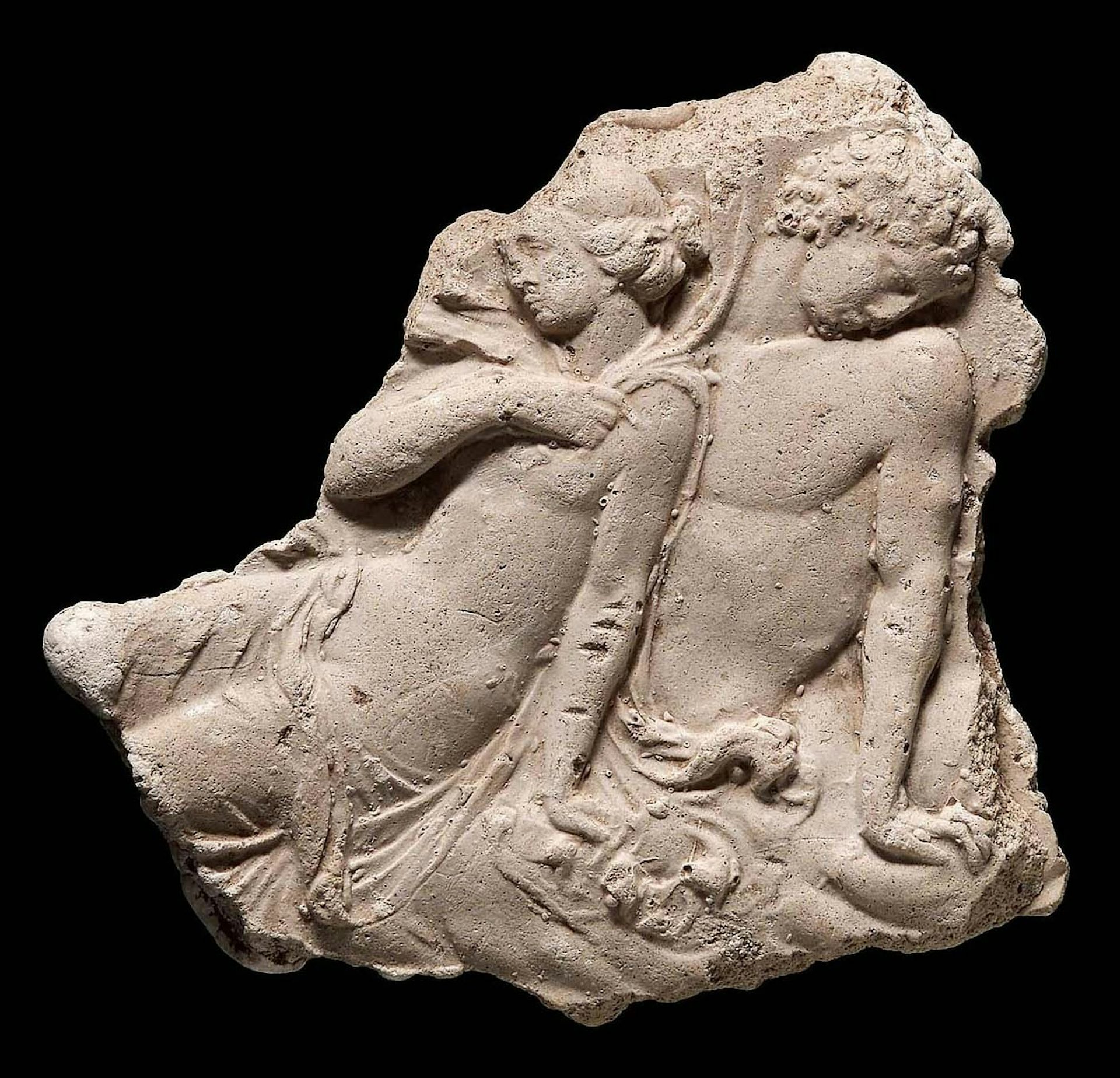
Fragment of a plaster relief with Aphrodite (left) and the young, handsome Adonis (3rd/2nd century BCE).
Museum of Fine ArtsPublic DomainAphrodite’s grief over Adonis became a focal point of the Adonia, a cultic celebration held in honor of Aphrodite and Adonis that was reserved for women alone.
Aphrodite the Punisher
The Lemnian Women
For all her love, Aphrodite could be as vengeful as any other deity. According to one tale, women on the island of Lemnos attracted her anger by refusing to offer sacrifices in her honor. In response, Aphrodite caused the women to stink so horribly that they became repugnant to their husbands.
Refusing the advances of their malodorous wives, the husbands of Lemnos instead opted to have sex with slaves. The aggrieved women then murdered both their husbands and the slaves. At this point, Jason and the Argonauts happened to visit Lemnos. Seeing that the island's population was in danger, the sailors consented to have sex with the foul-smelling women. The island was thus saved from extinction, and its women learned a valuable lesson about Aphrodite.
Hippolytus
The sad story of Hippolytus once again puts Aphrodite’s jealousy on full display. This myth is best known from Euripides’ fifth-century BCE tragedy Hippolytus, which presents the following story. Hippolytus, a son of the Athenian king Theseus, was devoted to the worship of the virgin goddess Artemis; as a faithful acolyte, he refused to partake in sexual activities. Taking this as a personal affront, Aphrodite promised revenge: she caused Phaedra, Hippolytus’ stepmother, to fall hopelessly in love with the young man.
Aphrodite knew that Hippolytus, a devoted follower of Artemis, would refuse his stepmother's advances. When he did so, the jilted Phaedra committed suicide, leaving a note that accused Hippolytus of trying to rape her.[34]
When Hippolytus’ father, Theseus, read the note, he promised vengeance for this imagined act and asked Poseidon to help him murder Hippolytus. Poseidon obliged, sending a wild bull to attack Hippolytus as he was riding his chariot along a rocky shoreline. The bull scared the horses and Hippolytus smashed into the cliffs, becoming mortally wounded in the process. Theseus finally discovered his son’s innocence from Artemis, but it was too late: Hippolytus was dead, and Aphrodite had had her vengeance.
Hippomenes
In some traditions, Aphrodite also played a role in the myth of the great female heroine Atalanta. When Atalanta had grown into a woman, her father tried to force her to take a husband. But she would only consent to marry the man who could beat her in a footrace. Conquered by her beauty, many tried this challenge and failed.
Hippomenes (called Melanion in some sources)[35] was one of Atalanta’s suitors. He knew he would need to use cunning to beat Atalanta and make her his wife. Thus, he prayed to Aphrodite for help, who gave him three golden apples that he was to drop whenever Atalanta began to gain on him. Hippomenes did as he was told, and Atalanta stopped to pick up each apple; this slowed her down enough for Hippomenes to win the race.
But according to some sources, Hippomenes did not properly thank Aphrodite after winning Atalanta’s hand. She therefore exacted a twisted revenge. Aphrodite caused Hippomenes and Atalanta to be overcome by desire while in a temple; the two began to make love right there on the sacred ground. This offended the gods, who transformed Hippomenes and Atalanta into lions as punishment for their sacrilege.[36]
Psyche
The story of Psyche, possibly a later invention, is told in Apuleius’ late second-century CE Roman novel The Golden Ass.[37] Psyche was a young princess so beautiful that she excited the jealousy of Aphrodite (or Venus) herself. Aphrodite tried to punish the girl by instructing her son Eros (or Amor) to make her fall in love with a monster. Instead, Eros fell in love with Psyche himself; he seduced her and promised they would live happily ever after as long as Psyche never gave in to her curiosity and tried to discover his true identity.
One night, however, Psyche snuck up on Eros with a candle as he was sleeping to get a look at him. He woke up and, furious at Psyche for her lack of trust, banished her. Psyche spent a long time wandering and searching for her beloved; eventually, she came to the palace of Aphrodite, who treated her as a slave and subjected her to many grueling and humiliating labors. In the end, however, Aphrodite managed to forgive the girl, and Psyche and Eros were reunited.
Myrrha
In another myth, an Eastern princess named Myrrha offended Aphrodite.[38] To punish the girl, Aphrodite caused her to fall in love with her own father. Myrrha managed to trick her father into sleeping with her, but when he found out what he had done, he was disgusted and banished his daughter. The devastated Myrrha ran into the wilderness, where she was transformed into the myrrh tree (smyrna in Greek).[39]
Aphrodite the Creator
Pandora
According to Hesiod, Aphrodite played an important role in the creation of the first mortal woman, Pandora. She made Pandora beautiful so that she would be desired; she also imbued Pandora with desires of her own, thus ensuring that humankind would be forever tempted.[40] In the end, Pandora was enticed to reveal the contents of her pithos (a uterus-shaped jar, often mistranslated as “box" and used colloquially to refer to a womb), an event that unleashed misery and death upon all humans.
Pygmalion
Aphrodite also played an important role in the myth of Pygmalion, as told in Ovid’s Metamorphoses.[41] Pygmalion was a sculptor living in Cyprus who made a statue of a woman so beautiful that he fell in love with it; he dressed the statue in fine clothing and even slept with it. Desperate to see his love reciprocated, Pygmalion prayed to Aphrodite, begging her to turn the statue into a real woman. In the end, Aphrodite answered Pygmalion’s prayers and gave life to the beautiful statue.
Aphrodite and the Trojan War
The Greeks liked to blame women for their troubles; such was the case with the Trojan War, the most important and impactful of all mortal conflicts in Greek mythology. According to legend, Hera, Athena, and Aphrodite were at fault for inciting the war; it was Aphrodite, however, who bore the heaviest weight of responsibility.
The events leading up to the Trojan War began with a petty disagreement among Hera, Athena, and Aphrodite over who was the most beautiful. To resolve the issue once and for all, they decided to have a contest: the winner would receive a golden apple inscribed with the words “to the fairest.” Zeus commissioned Paris, prince of Troy, to make the final decision.
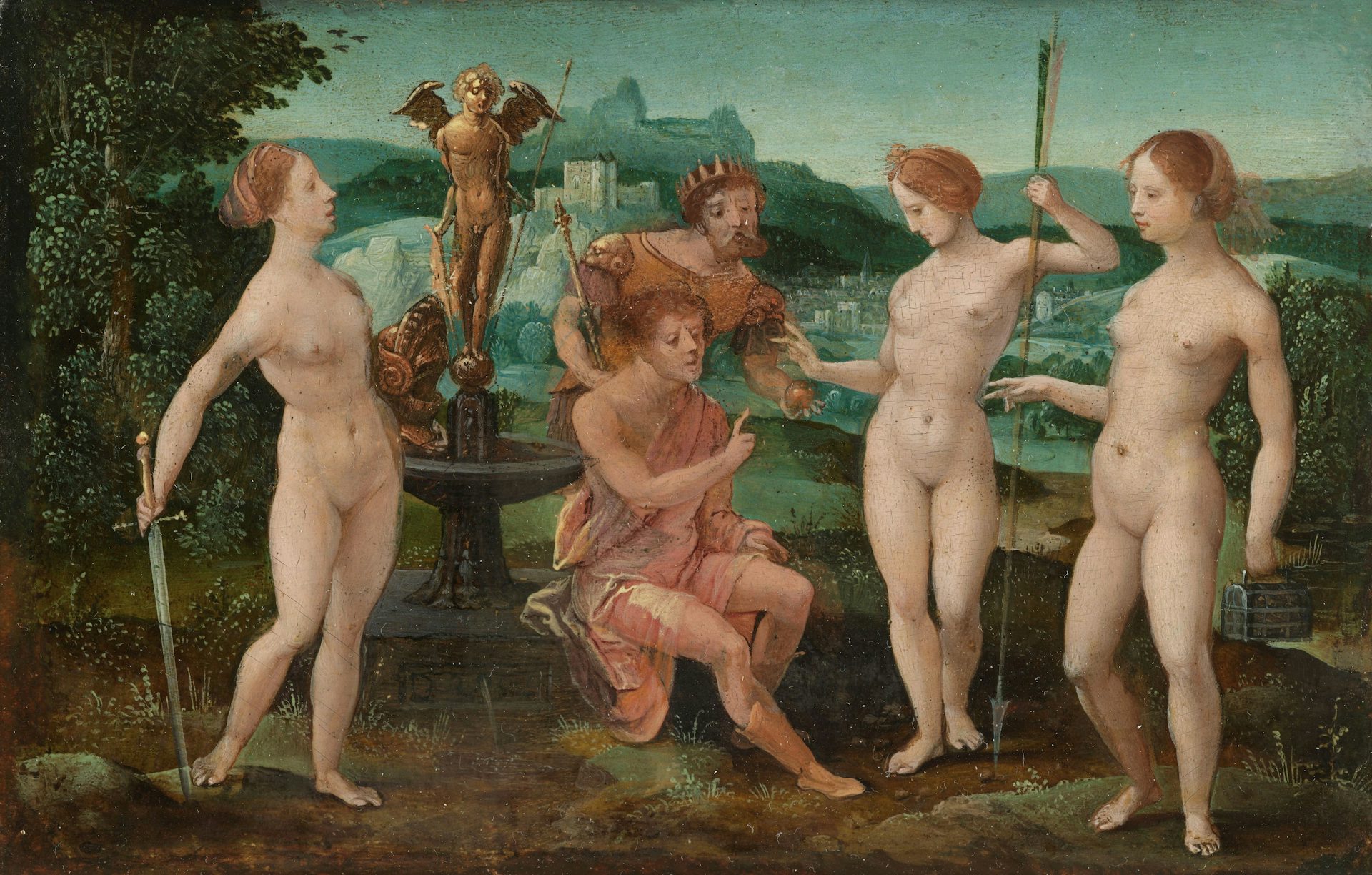
The Judgment of Paris by the Master of the Female Half-Lengths (1532).
RijksmuseumPublic DomainEager to settle the matter, the goddesses appeared before Paris (in some versions, unclothed), but he was reluctant to choose. The goddesses then resorted to bribes—Hera promised political power, while Athena promised wisdom and military glory. It was Aphrodite, however, who offered Paris the most beautiful mortal woman alive. Paris chose the latter gift, which happened to be Helen, wife of King Menelaus of Sparta. In fulfillment of her promise, Aphrodite helped Paris abduct Helen and bring her to Troy; it was this act that ultimately sparked the conflict.
During the war, Aphrodite consistently defended the Trojans and personally watched over the fortunes of Paris and Helen. In Homer’s Iliad, for example, she intervened to rescue Paris after he challenged the mighty king Menelaus to hand-to-hand combat.[42] Later, she returned to save her son, the Trojan hero Aeneas, from the Greek warrior Diomedes. But Diomedes immediately turned on Aphrodite and wounded her in the arm.[43] According to some traditions, Aphrodite eventually punished Diomedes by turning his wife against him and causing him to be exiled from his home.[44]
Aphrodite’s son Aeneas managed to escape from Troy after it was finally conquered by the Greeks. She then helped him find his way to Italy, where he founded the city of Lavinium and became the ancestor of the Romans. Naturally, this myth was far more prevalent in Roman literature than in Greek mythology.
Worship
Festivals
The festivals of Aphrodite were usually called Aphrodisia. Large annual festivals to the goddess were held in the cities of Paphos and Amathus in Cyprus, as well as in other major cities such as Athens and Corinth. Some Aphrodisia festivals seem to have involved symposia (dinner parties) held in the company of courtesans.[45]
Aphrodite was also celebrated privately. In many Greek cities and towns, for example, girls would sacrifice to Aphrodite on the night before their wedding so that their first sexual encounter would be favorable.[46]
Temples
Aphrodite’s most splendid temples were located in Cyprus, especially in the cities of Paphos and Amathus. The temple of Aphrodite at Amathus was even said to house the mythical Necklace of Harmonia, which gave its wearer eternal youth but also bore a terrible curse.[47]
Aphrodite had important temples throughout Greece, including at Athens, Corinth, Sparta, and Cythera, but her worship also penetrated deep into the Mediterranean: there are temples of Aphrodite in Italy, Sicily, and Asia Minor.
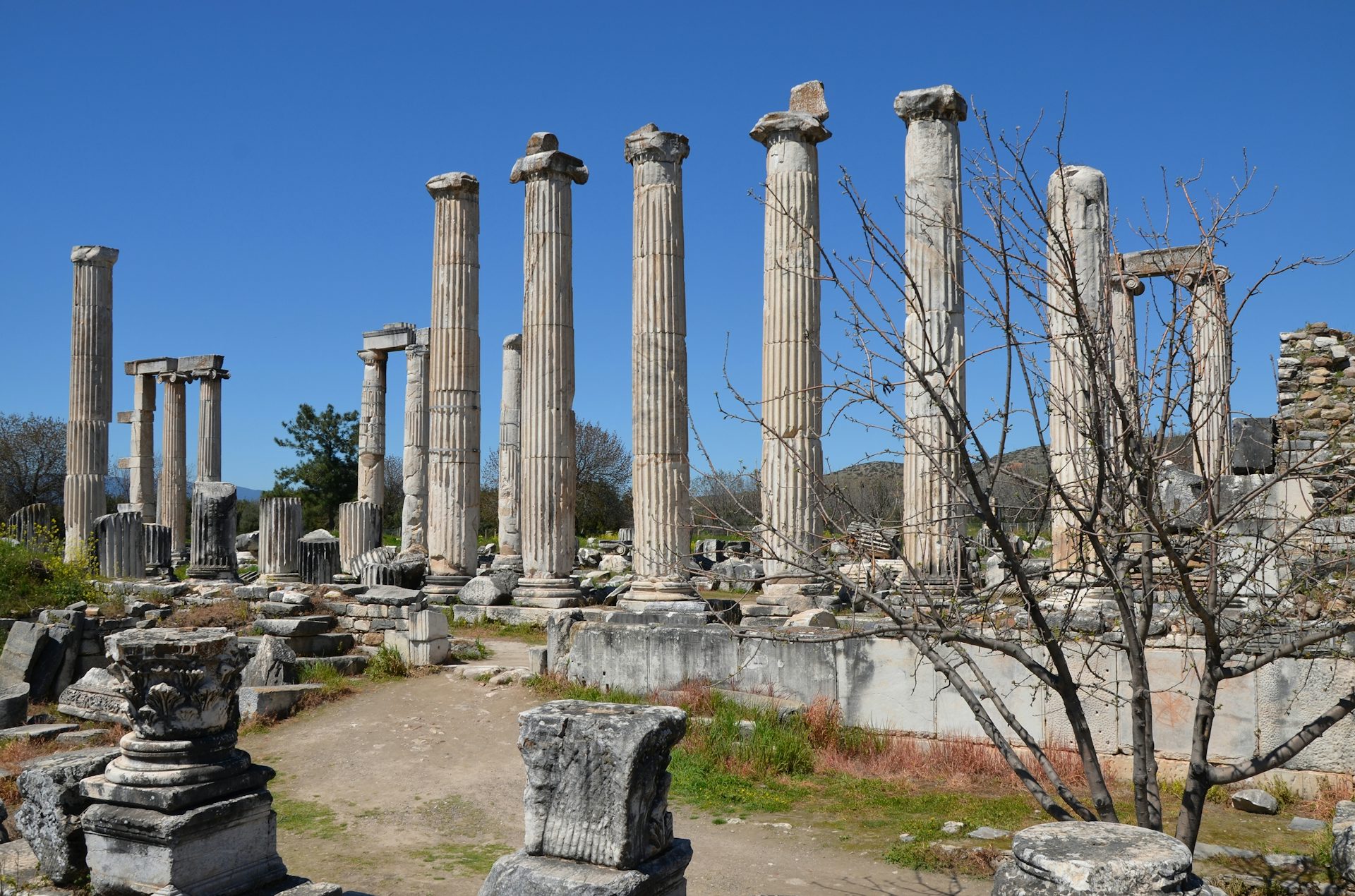
Temple of Aphrodite in Aphrodisias, Turkey (1st century BCE). The presence of Aphrodite's temple in western Turkey reveals the extent of her worship (and Hellenic influence) throughout the Mediterranean.
Carole RaddatoCC BY-SA 2.0Aphrodite sometimes played a surprising role in local cults. At some temples in northern Greece, such as those at Cassope, Epirus, and Metropolis, she appears to have been worshipped primarily as a goddess of the polis (the city-state). In others, such as Corinth, Sparta, and Cythera, she was worshipped as a war goddess associated with Ares (“Aphrodite Areia”).
In the Hellenistic period (323–31 BCE), Aphrodite was increasingly identified with Egyptian goddesses such as Hathor and Isis. She also had numerous temples throughout Greek Egypt, from Alexandria in the north to Philae in the south.
The Romans worshipped Aphrodite as Venus. According to the Roman historian Livy, this identification was first officially instituted at the end of the third century BCE when the cult of Venus Erycina—that is, Venus of Mount Eryx in Sicily—was imported to Rome.[48]
Later, as the Romans increasingly adopted Aphrodite’s son Aeneas as their ancestor, Venus became even more important, and numerous temples to her were built across the Roman world. In this function, the goddess came to be known as Venus Genetrix (“Mother Venus”). Indeed, one of Venus’ most important temples was the temple of Venus Genetrix that Julius Caesar built on the Roman Forum shortly before his death in 44 BCE.
It was once fashionable for scholars to suggest that the temples of Aphrodite practiced “sacred prostitution” or “temple prostitution,” meaning prostitutes would come to the temple and sleep with the men who arrived seeking companionship. Sacred prostitution does seem to have existed in parts of the Middle East, especially in the temples of Ishtar or Astarte, the Semitic goddess of love.[49] Most scholars today, however, admit that there is no substantial reason to think that sacred prostitution was practiced in connection with Aphrodite.[50]
Pop Culture
Aphrodite has often appeared in popular culture as a symbol of beauty and love. During the Renaissance and early modern periods, she was frequently depicted in art as the embodiment of feminine beauty.
In more recent times, Aphrodite has maintained a lively presence. In the television series Hercules: The Legendary Journeys and Xena: Warrior Princess, for example, Aphrodite is a gossipy, love-obsessed character, appearing in anachronistic pink lingerie. She is also an important character in the Rick Riordan book series Percy Jackson and the Olympians, which was later adapted for film, stage, and television.
The ancient goddess's name has also been appropriated by the beauty company Aphrodite Skin Care, whose products promise “the secret of natural beauty.”
Figure 1

The Birth of Venus by Alexandre Cabanel (1875)
The Metropolitan Museum of ArtPublic DomainFigure 2

The remains of the sanctuary of Aphrodite at Paphos in Cyprus
rene boulayCC BY-SA 3.0Figure 3

Mosaic showing the Judgment of Paris from the triclinium of the Atrium House in Antioch-on-the-Orontes (ca. 115–150 CE)
Louvre Museum, Paris / Marie-Lan NguyenPublic Domain